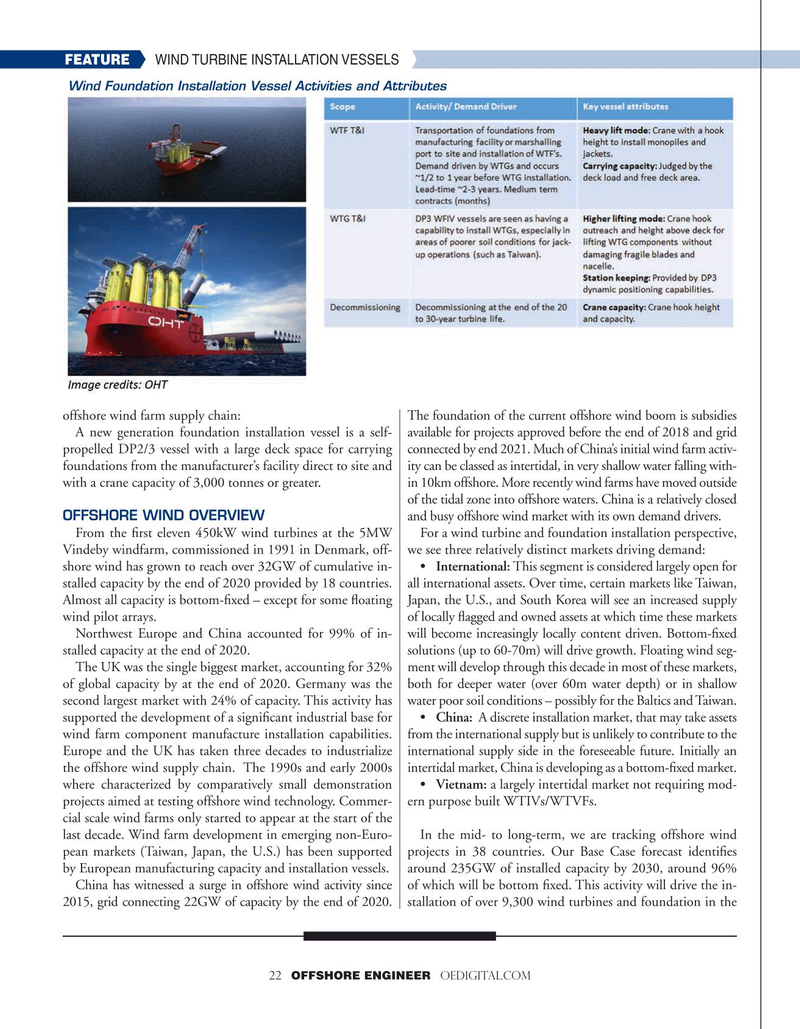
Page 22: of Offshore Engineer Magazine (Jul/Aug 2021)
The Robotics Revolution
Read this page in Pdf, Flash or Html5 edition of Jul/Aug 2021 Offshore Engineer Magazine
FEATURE WIND TURBINE INSTALLATION VESSELS
Wind Foundation Installation Vessel Activities and Attributes offshore wind farm supply chain: The foundation of the current offshore wind boom is subsidies
A new generation foundation installation vessel is a self- available for projects approved before the end of 2018 and grid propelled DP2/3 vessel with a large deck space for carrying connected by end 2021. Much of China’s initial wind farm activ- foundations from the manufacturer’s facility direct to site and ity can be classed as intertidal, in very shallow water falling with- with a crane capacity of 3,000 tonnes or greater. in 10km offshore. More recently wind farms have moved outside of the tidal zone into offshore waters. China is a relatively closed
OFFSHORE WIND OVERVIEW and busy offshore wind market with its own demand drivers.
From the frst eleven 450kW wind turbines at the 5MW For a wind turbine and foundation installation perspective,
Vindeby windfarm, commissioned in 1991 in Denmark, off- we see three relatively distinct markets driving demand: shore wind has grown to reach over 32GW of cumulative in- • International: This segment is considered largely open for stalled capacity by the end of 2020 provided by 18 countries. all international assets. Over time, certain markets like Taiwan,
Almost all capacity is bottom-fxed – except for some foating Japan, the U.S., and South Korea will see an increased supply wind pilot arrays. of locally fagged and owned assets at which time these markets
Northwest Europe and China accounted for 99% of in- will become increasingly locally content driven. Bottom-fxed stalled capacity at the end of 2020. solutions (up to 60-70m) will drive growth. Floating wind seg-
The UK was the single biggest market, accounting for 32% ment will develop through this decade in most of these markets, of global capacity by at the end of 2020. Germany was the both for deeper water (over 60m water depth) or in shallow second largest market with 24% of capacity. This activity has water poor soil conditions – possibly for the Baltics and Taiwan. supported the development of a signifcant industrial base for • China: A discrete installation market, that may take assets wind farm component manufacture installation capabilities. from the international supply but is unlikely to contribute to the
Europe and the UK has taken three decades to industrialize international supply side in the foreseeable future. Initially an the offshore wind supply chain. The 1990s and early 2000s intertidal market, China is developing as a bottom-fxed market.
where characterized by comparatively small demonstration • Vietnam: a largely intertidal market not requiring mod- projects aimed at testing offshore wind technology. Commer- ern purpose built WTIVs/WTVFs.
cial scale wind farms only started to appear at the start of the last decade. Wind farm development in emerging non-Euro- In the mid- to long-term, we are tracking offshore wind pean markets (Taiwan, Japan, the U.S.) has been supported projects in 38 countries. Our Base Case forecast identifes by European manufacturing capacity and installation vessels. around 235GW of installed capacity by 2030, around 96%
China has witnessed a surge in offshore wind activity since of which will be bottom fxed. This activity will drive the in- 2015, grid connecting 22GW of capacity by the end of 2020. stallation of over 9,300 wind turbines and foundation in the 22 OFFSHORE ENGINEER OEDIGITAL.COM

 21
21

 23
23